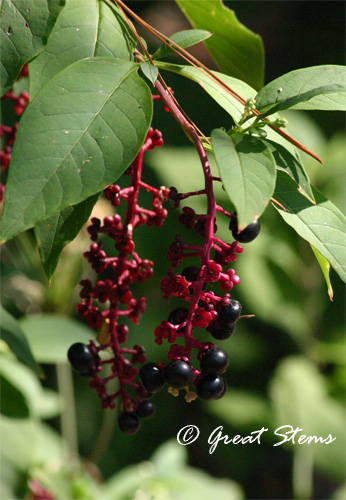 I’ve recently learned to recognize pokeweed, and wouldn’t you know it, it’s on our school campus (the picture above isn’t from school; it’s from a recent visit to McKinney Roughs). Well, shortly the plant won’t be at the school any longer. All parts of it are considered highly toxic to humans, and for our kids’ safety, the plant has to go (it was right by the Kindergarten wing, as well). I apologize to the nearby birds — I’ll plant three more berrying plants in my own yard just to make up for it. It’s such a shame — what a great native wildlife plant.
I’ve recently learned to recognize pokeweed, and wouldn’t you know it, it’s on our school campus (the picture above isn’t from school; it’s from a recent visit to McKinney Roughs). Well, shortly the plant won’t be at the school any longer. All parts of it are considered highly toxic to humans, and for our kids’ safety, the plant has to go (it was right by the Kindergarten wing, as well). I apologize to the nearby birds — I’ll plant three more berrying plants in my own yard just to make up for it. It’s such a shame — what a great native wildlife plant.
I did get the pokeweed berries off right away, since they might look enticing to a hungry youngster or foolish adult, and I’ll pull the whole plant out very soon. Then I did what any good mom would do — I took the poisonous berries home right away to do a project with my kids. No, not that kind of project… geez!
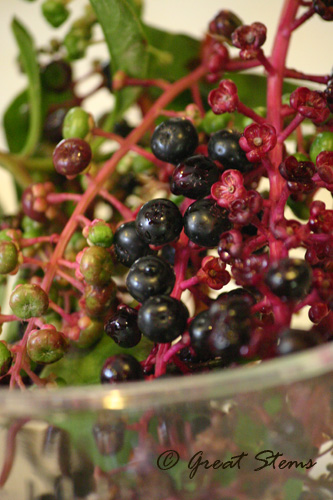 According to multiple sources, fermented pokeweed ink was used to write
According to multiple sources, fermented pokeweed ink was used to write the Declaration of Independence, as well as letters during the Civil War. (Edit: Thanks to Dana R., who contacted the National Archives and found out that the Declaration and the Constitution were written in iron gall ink — this means another ink-creating experience awaits me!) Native Americans used the berry juice to decorate their horses and dye cloth, and even used it for war paint. But given that the toxins from the juice can be absorbed through the skin, you won’t find me recreating that part of history.
What did appeal to me, however, was making ink. I donned gloves and carefully crushed them to all sorts of juicy greatness.
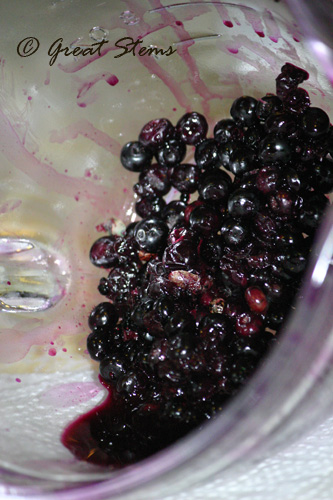 I then strained the mixture through pantyhose into a funnel (this last part was cool — with my gloves on and all the red juice squeezing out from the stained lump, I looked like a surgeon massaging a heart — granted the heart was about the size of that of a chicken, but still it was c-o-o-l cool). And from the funnel, the juice flowed into a small bottle.
I then strained the mixture through pantyhose into a funnel (this last part was cool — with my gloves on and all the red juice squeezing out from the stained lump, I looked like a surgeon massaging a heart — granted the heart was about the size of that of a chicken, but still it was c-o-o-l cool). And from the funnel, the juice flowed into a small bottle.
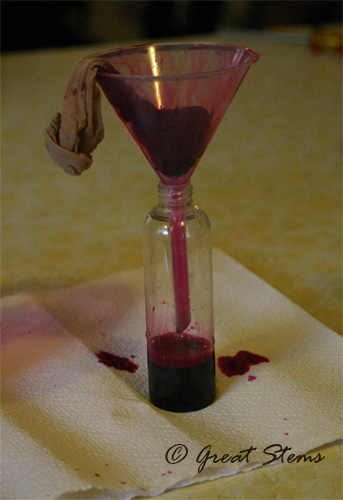 Next I added a pinch of yeast to the liquid to help it ferment. I’m keeping the liquid out of the sun, too, so that it doesn’t turn brown right away from the UV rays. That cork is just there for show right now, as I need to let the gases escape during fermentation.
Next I added a pinch of yeast to the liquid to help it ferment. I’m keeping the liquid out of the sun, too, so that it doesn’t turn brown right away from the UV rays. That cork is just there for show right now, as I need to let the gases escape during fermentation.
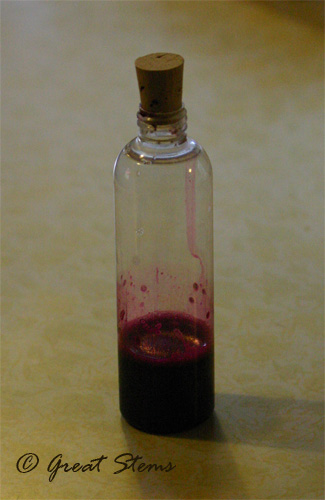
I’m going to teach the kids a little calligraphy, I think, to go along with the ink. Hopefully in a few days I’ll get to update the ink report with sample writing. What fun! (EDIT: My son ended up using the ink for a nifty visual for his Social Studies project on the American colonies.)
Note: I talked to a teacher about making this a lesson for the Social Studies classes at school, but the timing was all wrong for either studying about Native Americans or the later American history. Perhaps if I still have ink, I can share it with them then. Or maybe I’ll be able to find some more pokeweed berries elsewhere and enjoy another project.
Meredith, You actually know how to make ink? Can it be used to dye the hair red? Just kidding.
Was wondering if you could use a plastic bottle instead of glass. Then if you decide to close the cover, there is some space for expansion.
I think your hair would more likely be purple, haha. But boy I wouldn’t want that toxic stuff near my brain cells — they’re having a rough enough time as it is!
This is an awesome project – I’d love to try it!
Fun and easy. Looking forward to writing with it.
Meredith, I just stumbled upon your page looking up an odd caterpillar that my husband and I found out back. I love your site, and will be visiting it often now. I hope to get into gardening next spring. I just had a baby and well haven’t been able to do much the past two years, whilst being pregnant and then having the baby and then this year, he is just waaaaay too busy.. HAHA but thanks for sharing all of these amazing things. And I LOVE this ink idea! Thanks again,
Shari
It won’t be long and your little one will be able to help you garden. It so much fun sharing the experience with them (and it teaches them patience while they wait for seeds and plants to grow!). I’m so glad you stopped by Great Stems for a visit!
You are amazing! Need more? I have one huge plant over here which I keep meaning to pull out before that darned mocking bird tucks in and then leaves inky patches on my patio!
I guess there are plenty of other bushes to take their place but I worry that people get carried away and we “dummy down” our society because nitwits just eat any old berry on a bush. If we remove every poisonous plant, we will just have a monoculture of “safe” stuff and then they will die out. Keep the poisonous ones, just use the brain, folks!
We had to make ink for a school project and used blueberries and cranberries. It was messy but fun.
Jenny — well, I think I’ll work with this one plant for now. Thanks for your most generous offer, though, haha!
Rosey, I do agree with you. The problem is that these berries are right along the Kindergarten wing, and the school would be liable if anything did happen. I’m debating about whether to bring the plant home with me, though — or maybe I’ll find a spot in the woods for it.
I have pokeweed in my garden. I had nor idea it was so toxic! The berries are so pretty, that I could see it might be a problem if there are children, who might decide to pick it. My “child” is over twenty and so I don’t have the same worry. It is neat that you decided to make declaration style ink. If you do old style calligraphy, aren’t you worried about getting ink on your fingers?
My grand parents on both sides of the family loved to eat Poke Weed as a green. They would boil it twice before serving it. I remember Mamaw Bohannon saying that if you didn’t boil it twice that it was poisonous. I always wondered about the first person who boiled it and ate it and died and some one saying “I know, lets boil it again and, uhhh, you can try it”. I tried it and it tasted worse than collard greens, really bad.
From my experience over a number of years, Pokeweed is not the hideous plant many fear it to be. I have cookbooks that mention how to cook the leaves and it is full of vitamins. One just has to follow directions. It’s really not a big deal. It tastes great and after it is done, we mix it with cooked Lambsquarters also known as Goosefoot greens. We use the full sized Poke leaves. We have never had any problems. My understanding is that if one ingests a quantity of the raw plant material, there may be severe vomiting and diarrhea, but one will not immediately drop dead.
I have used the berries to experiment with dyeing yarns etc. in the past including getting it on my hands with no side effects other than unattractive stains on my skin for awhile.
The berry juice used to be used to color Port Wine and some cheeses etc. Some people use small quantities of the berries not the seeds to treat arthritis and other ailments.
This plant is very useful to both birds and humans and is beautiful as well. I see how the berries would be very attractive to children who have not been educated on its use.
We have tons of it in our yard and have enjoyed the culinary aspects all summer and am hoping to use the berry juice for ink, dye, paintings, drawings and hope the birds enjoy it too. For us, the purple poo stains are a small price to pay for having songbirds grace us with their presence. Golly, can you tell we love Pokeweed?
I love hearing that you are such a fan of Pokeweed. I do respect its many values. You are definitely making me lean toward the idea of moving it to my yard from the school grounds. I don’t mind the berry poop. Thanks for all the info!
Awesome!
Cool project!
I have these growing all over my yard, at least a dozen individual plants. The birds love to eat them. I’ve been living here for 49 years and one of the first thing my parents taught me is NEVER eat any berries or mushrooms that grow in the yard, that’s it.
I do not have children so if they go in my yard, it’s at their own risk.
I just cut the stalks to the ground in late fall when I “harvest” all the weeds.
If there was some way to make the berries not toxic I sure would like to know.
There are so many poisonous berries out there — I definitely learned at a young age not to eat red berries, but I know kids who have swallowed some to their parents’ alarm (they all were okay, but eek). The pokeweed at the school was just too much of a risk when there’s no knowing whether some kids have never been taught basic plant safety.
I just stumbled onto your website as I have been interested in pokeweed ink lately and just a few weeks ago, actually called the National Archives to find out if the rumors about the Declaration (and I’d also heard the Constitution) were true. Alas, they were written using iron gall ink, not pokeweed.
However, iron gall ink is botanically interesting too, as it is made using wasp galls that form on oak trees! Just thought you might be interested in these tidbits!
Ooh, interesting! Thanks for finding this out — I might just have to figure out how to make iron gall ink, now!
Hiya!
I would love to know how you learned that fermentation makes this ink permanent. If you ferment the sugars in the berry juice, you turn your ink to a colored alcohol.
My understanding of pokeweed berries is that they will dye but require a high pH mordant (like sodium carbonate) to become colorfast. Any insight?
Ah, a fine question — I didn’t mean to mislead that the fermentation affected the dye, just that the fermentation would help the ink last longer. (I edited the post so that it wouldn’t sound that way anymore). I honestly haven’t tested the ink on cloth to see just how colorfast it is — we played with the ink on paper only, and I’m not sure whether we still have the calligraphy samples after the project. I have a little more ink still, so when I have a chance, I’ll try to test it for that purpose. Thanks for your post, Stevo!
Thanks for posting the process for making ink..Had a plant show up in one of my pots and decided not to pull it as a weed..The leaves and stems with the purple color saved its life..Research pointed to being a Pokeweed that my father had talked about using for ink in the late 1930’s. Who knew? I have a pretty good script according to my sis, “for a man” so I went searching for a good fountain pen..Holy mackerel, the makers are really proud of their pens..Looks like I need to hit a few yard sales and flea markets and see what can be found..I plan on using the ink to exclusively sign very important contracts or documents..This way NO one will be able to forge my signature. Ya just can go to Office Depot and get a re-fill. Besides, each plant has it own DNA that could be matched to the ink reservoir. I think Ben Franklin would have been proud using mother nature to prevent forgery in another way..
Hi, Dave. Good luck with your ink endeavours! It was a fun experience for us here. Still have the leftover ink, in fact. Interesting idea about using it for documents — as long as “black or blue” ink is not required as is sometimes these days, it would definitely be unique!
Meredith, have you found papers that you used years ago with the Polk ink and is still visible. I am assuming it would be. How much yeast do you use and how long do you leave the cap off the bottle to let it ferment? My mom is an artist and uses all natural sources for painting. She is 83 and lives to do her artwork. She is amazing. One of my favorite painting she did was with beet juice. Another good one to use is the iris flower. Makes beautiful link. Really enjoyed your page.
Everything is still visible, Sheryl. You can see from the photos that I didn’t have many berries, and I added just a pinch of yeast. At this point I don’t recall how long I let it ferment — my guess is that you should base it on the bubbles you see it producing. That’s wonderful about your mom’s paintings — does she have a website for her artwork? I’d love to see some pictures!